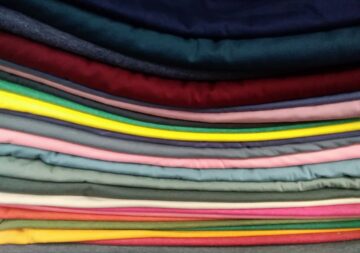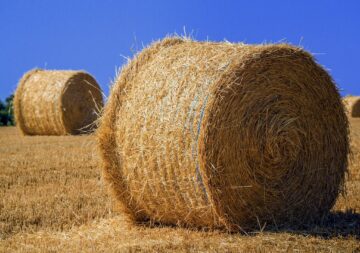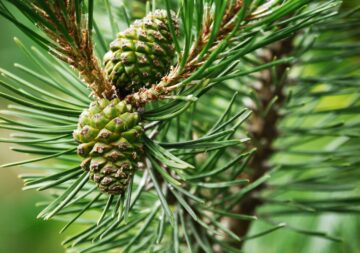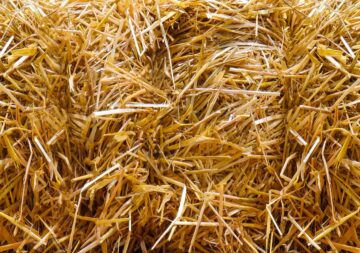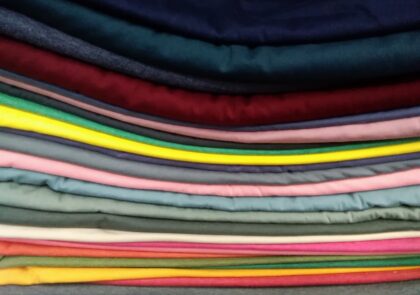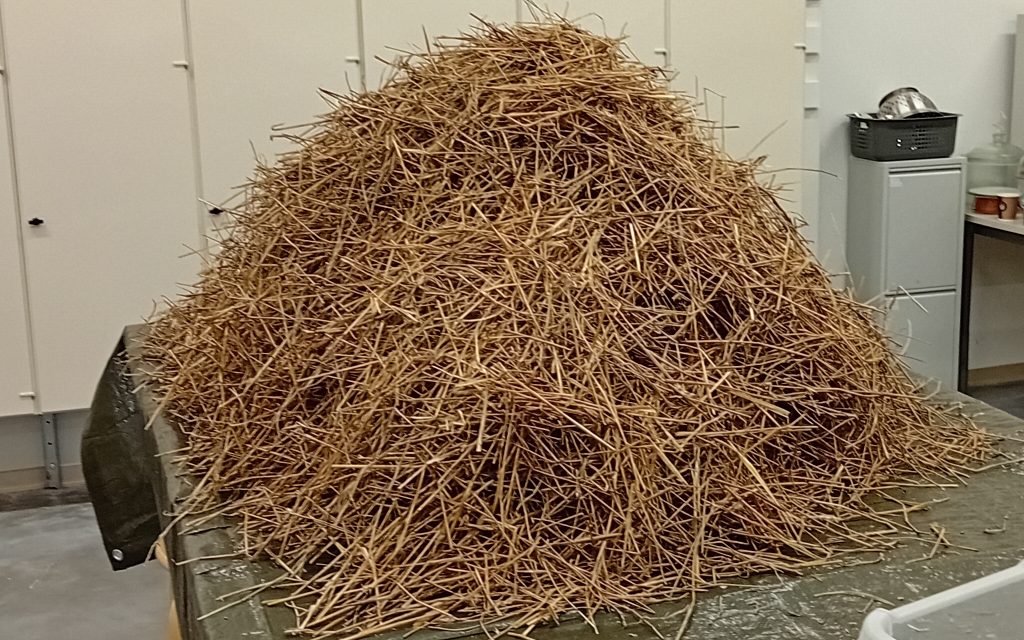
A joint research project of LAB and VTT studies wheat straw and oat husk in high-value biocarbon applications. Both are significant underutilised side streams of food production.
Author: Eliisa Punttila
In the BioCarbonValue project (Business Finland 2023-2024), LAB and VTT studies suitability of high-value carbons produced from agricultural and food industry biomasses in energy storage systems, biocomposites, and water purification processes (BioCarbonValue 2024). The project selected five interesting raw materials for carbonization and application tests: reed canary grass, willow, wheat straw, oat husk and wheat straw lignin. This article describes the availability and alternative utilization possibilities of wheat straw and oat husk in Finland.
Production volumes of wheat straw in Finland
There is no exact information on how much straw is collected annually in Finland, but the annual side stream potential of straw can be estimated from the cereal production. Techno-economical potential can be regarded as sustainable potential, since it aims to assess the amount that is technically possible and economically viable to collect and considers also the soil quality aspect. In Finland it is estimated to be 20-30 % from theoretical potential. (Pahkala & Lötjönen 2015, 20.) The theoretical potential can be calculated by using crop harvest index, which defines the proportion of the yield from the mass of the whole plant, which is typically 0.4-0.5 for cereals (Biomass Atlas 2024a).
The annual wheat crop yield in Finland in 2015–2024 was on average 770,000 tons (Luke 2024b). Theoretical potential would then be 770,000-1,160,000 tons of straw. If 20-30 % of straw is collected, there would be around 150,000-350,000 tons of straw sustainably available. A part of this would be used in farms as bedding material and feed, but a majority could be used in bioeconomy purposes. If also barley, oat and rye straw is included, the sustainably availability of straw would be 650,000-1,500,000 tons annually.
However, Finland covers only 0.32% of the Europe’s annual wheat production, which was on average 260 million tons during past ten years 2013–2022. The largest wheat producers have been France, Ukraine, Germany, UK and Poland. (FAOSTAT 2024.)
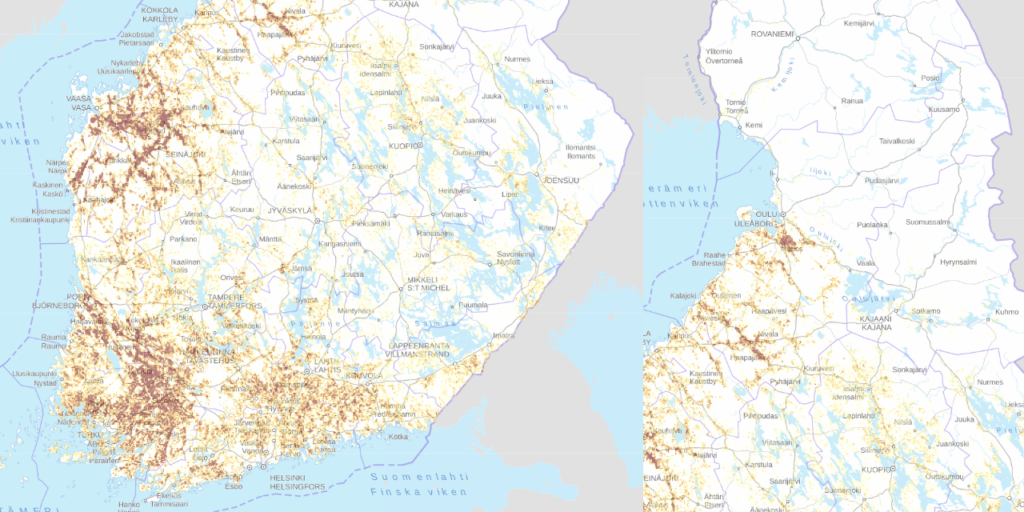
Picture 1. Straw side-stream potential in Finland ( Biomass Atlas 2024b, modified by Eliisa Punttila).
Sustainability of straw collection
The sustainability aspect in straw collection is very important to consider. Typically, straw is crushed and cultivated to soil to improve soil structure and fertilize it. Kasurinen et al (2021) considered both climate and soil impacts of straw collection. The climate impacts from the point of view of the carbon sequestration, nitrogen and methane emissions and CO2 emissions from machinery, may vary depending on the harvesting height, cultivation practices, soil properties and climate conditions.
The life-cycle-assessment made by Leppäkoski et al (2022) for oat straw obtained that the carbon footprint is low, although the sign depends on whether straw is considered as waste or side-stream. The total climate emission balance at a system level could be calculated only after considering also the straw processing and manufacturing of replaced final products (Leppäkoski et al 2022). Straw removal may cause need for additional fertilizing and have impact on soil structure. These impacts could to some point be reduced by diversified crop rotations and catch crops. (Kasurinen et al 2021.)
At EU level the sustainability criteria for straw use in bioenergy production are developed during recent years. Directorate-General for Energy of European Commission (2021) have provided recommendations of cultivation practises to sustain soil quality, which include crop rotation, cover/catch crops, prevention of soil compaction, avoidance of burning field waste and liming of acidic soils. Criteria have also assessed in Finnish conditions by Lång et al (2021). In case of straw, if over 50 % of biomass is left in the field, it could be considered as sustainable feedstock for energy production (Lång et al 2021, 15). These sustainability criteria could be perhaps also applied if straw is used in biocarbon production.
Industrial utilisation of straw
In Finland, the straw is very seasonal biomaterial and weather conditions have high impact on the collection possibilities. The harvest season is short in autumn and the time frame for straw collection is very narrow. Organising a regional supply network for large-scale industrial use would require various solutions in volume and quality management especially in the logistics and storage of straw, although the supply potential of straw among farmers would exist (Punttila et al 2021).
The current bioeconomy use of straw is focused on energy and fuel production, but it is more common in other European countries than Finland. For example, in Denmark straw is a significant source of renewable energy (Skøtt et al 2020). In biogas production, there are only few plants in Finland, but it is more common in Europe (Ahokas 2021, 12-14). Industrial scale utilisation of straw has been challenging in Finland. In Kouvola, a large bioethanol plant has been in plans for ten years but has not yet realised due to the changing reasons, the uncertainty of availability of required huge amount of straw as the latest (Kujala 2023). Ten years ago, a plan to build bio-oil plant using straw from 100,000 ha area revealed as nonprofitable, but the research has continued (MT Toimitus 2014; Neste Oyj 2020).
Straw includes many value components and nutrients, which should be considered together with energy and fuel production (Luostarinen et al 2021). Fractioning straw to lignin, hemicellulose and cellulose provides raw materials for various of industries, for example for packages, textiles, cosmetics and food industry (Tolonen 2023). Current fractionation technology enables to utilise the raw material almost completely (Chempolis 2024).
Availability and use of oat husk
Another side-stream studied in the BioCarbonValue project is oat husk. Oat husk is the protecting cover of oat grain.
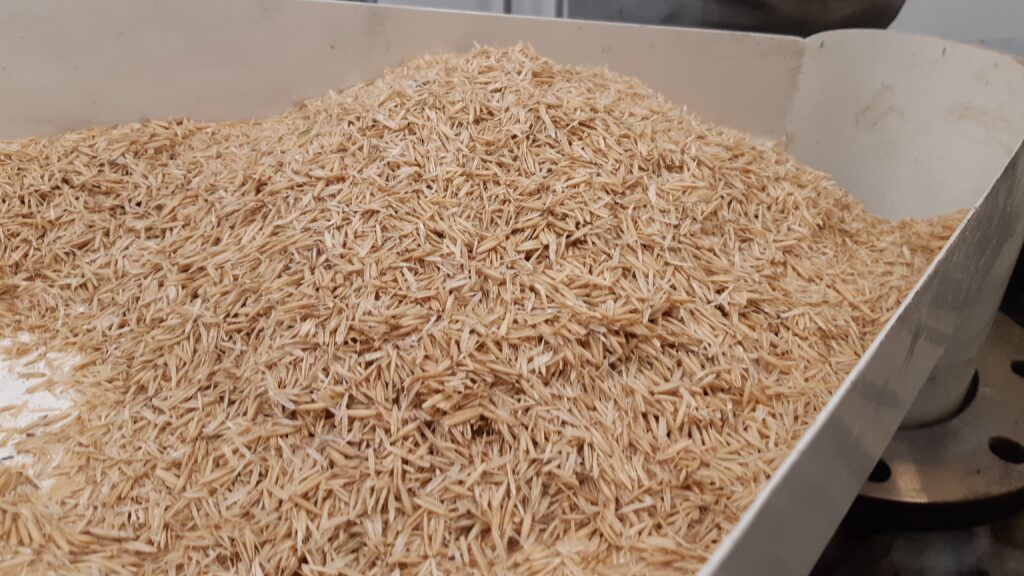
Picture 2. Oat husks (Ruokamo 2024)
Finland was the second largest oat producer in Europe in 2023 after Poland with a production of 1 million tons. In total, oat is produced 6 million tons in EU member states. (Eurostat 2024.) In 2022, Finland was globally the sixth largest oat producer (FAOSTAT 2024). Majority of produced oat is used in animal feeding in farms (Leipätiedotus 2024). Oat was used in food and feed industry on average 1.7 million tons annually in 2019–2023 (Luke 2024a). As about 25% of oat grain is husk (Leipätiedotus 2024), the annual amount includes around 400,000 tons oat husk.
Oat husk as a side stream from oat mills is mainly used in bioenergy and animal feed production in Finland. For example, oat mill in Rauma produces 35,000 tons of oat husk pellet for bioenergy and feed use (Suomen Viljava Oy 2021). In Utajärvi, 6,000 tons of oat husk from oat mill is used entirely in energy production (Nevel 2020). However, oat husk is arising feedstock for circular economy solutions. Today it is utilised in xylitol production (Niemi 2022) and in fertilizers (Ikonen 2024). In Raisio, a biorefinery using oat husk and straw of 27,000 tons annually is planned to be start the production next year (Raision kaupunki 2024).
Conclusions
This article considered two side streams of food production: wheat straw and oat husk. If we consider straw in general, in Finland there is high-level technological solutions which can utilize straw almost entirely, but so far, the side-stream potential has not been utilized in industrial scale despite of various of plans, due to the challenges in profitability and logistics chain. The sustainability of straw collection is very strongly linked to sustainable farming practices.
Oat husk has a different position. Ways to utilize the side stream are needed or it will end up as waste. The sustainability of oat husk as raw material depends also the sustainability of farming practices in oat production but also the alternatives how it is disposed or utilized.
References
Ahokas, L. 2021. Olkibiomassan käyttö biokaasuprosessissa. Bachelor’s thesis. Turku University of Applied Sciences. Turku. Cited 14 October 2024. Available at https://urn.fi/URN:NBN:fi:amk-2021061516074
BioCarbonValue. 2024. Cited 21 October 2024. Available at https://www.biocarbonvalue.fi/
Biomass Atlas. 2024a. Field biomasses in Biomass Atlas: Main yields and side stream biomasses. Cited 16 August 2024. Available at https://projects.luke.fi/biomassa-atlas/en/biomasses/763-2/
Biomass Atlas. 2024b. Biomasses, Crop sidestreams 2021, t/y, Cereal straw. Cited 18 October 2024. Available at https://biomassa-atlas.luke.fi/?lang=en
Chempolis Oy. 2024. Technologies & Solutions. Cited 17 October 2024. Available at https://chempolis.com/technologies-solutions/
Directorate-General for Energy of European Commission. 2021. Technical assistance for the preparation of guidance for the implementation of the new bioenergy sustainability criteria set out in the revised Renewable Energy Directive – REDIIBIO – Final report, Publications Office. Cited 11 October 2024. Available at https://data.europa.eu/doi/10.2833/592471
Eurostat. 2024. Crop production in EU standard humidity. Cited 15 August 2024. Available at https://ec.europa.eu/eurostat/en/
FAOSTAT. 2024. Crops and livestock products. Cited 19 August 2024. Available at https://www.fao.org/faostat
Ikonen, P. 2024. Helsingin Myllyn kaurankuoret hyötykäyttöön Yaran kierrätyslannoitteissa. Uusiouutiset. Cited 8 August 2024. Available at https://uusiouutiset.fi/helsingin-myllyn-kaurankuoret-hyotykayttoon-yaran-kierratyslannoitteissa/
Kasurinen, H., Uusitalo, V. & Leppäkoski, L. 2021. Oljen pellolta poistamisen ympäristöllisen kestävyyden näkökulmia. Lappeenranta: Lappeenrannan-Lahden teknillinen yliopisto LUT. LUT Scientific and Expertise Publications. Raportit ja selvitykset – Reports 108. Cited 11 October 2024. Available at http://urn.fi/URN:ISBN:978-952-335-669-6
Leipätiedotus ry. 2024. Tietoa leivästä. Kaura (Avena Sativa). Cited 8 August 2024. Available at https://www.leipatiedotus.fi/tietoa-leivasta/vilja/kotimaiset-viljat/kaura.html
Leppäkoski, L., Uusitalo, V., Horn, S., Levänen, J., Kasurinen, H. & Härri, A. 2022. Assessing the climate impacts of oat straw as a raw material. Assessing the climate impacts of oat straw as a raw material. Cleaner Materials Vol. 5 (100133). Cited 11 October 2024. Available at https://doi.org/10.1016/j.clema.2022.100133
Luke. 2024a. Natural Resources Institute Finland. Statistical Databases. Table: Annual use of cereals and protein and oilseeds in industry (1000 kg). Cited 8 August 2024. Available at https://statdb.luke.fi/
Luke. 2024b. Natural Resources Institute Finland. Statistical Databases. Table: Production 1920- (million kg). Cited 18 October 2024. Available at https://statdb.luke.fi
Luostarinen, S., Saastamoinen, M. & Katajajuuri, J.-M. 2021. Olki, lanta ja puhdistamoliete – uusia tuotteita ja ravinteet kiertoon. In: Saranpää, P. (editor). Suomen biotalousstrategian päivitykseen liittyvä selvitys metsä- ja agrobiotalouden sivuvirroista ja niiden hyödyntämisestä. Luonnonvarakeskus. 4-5. Cited 14 October 2024. Available at https://www.biotalous.fi/wp-content/uploads/2021/09/Kooste-sivuvirtapotentiaalista-LUKE-2021.pdf
Lång, K., Palosuo, T., Heikkinen, J., Koikkalainen, K., Luostarinen, S., Miettinen, A. & Rasi, S. 2021. Selvitys maatalousmaasta peräisin olevia jätteitä ja tähteitä koskevasta seuranta- ja hallintajärjestelmästä. Luonnonvarakeskus (Luke). Helsinki. Cited 11 October 2024. Available at https://energiavirasto.fi/documents/11120570/12766786/Selvitys_Maatalousmaan+j%C3%A4tteet+ja+t%C3%A4hteet_LUKE_nettiin.pdf/e0a231d9-8f3e-3776-b5c5-98966791584a/Selvitys_Maatalousmaan+j%C3%A4tteet+ja+t%C3%A4hteet_LUKE_nettiin.pdf?t=1646383213128
MT Toimitus. 2014. Neste Oil ei rakenna olkidiesellaitosta. Cited 17 October 2024. Available at https://www.maaseuduntulevaisuus.fi/uutiset/c143e195-6be4-5181-a2a3-0fa9c2d83fdc
Neste Oyj. 2020. Neste kehittää raakaöljyn käyttöä vähentäviä uusia ratkaisuja ja lisää tutkimusta Suomessa. https://www.neste.fi/tiedotteet-ja-uutiset/vastuullisuus/neste-kehittaa-raakaoljyn-kayttoa-vahentavia-uusia-ratkaisuja-ja-lisaa-tutkimusta-suomessa
Nevel. 2020. Kinnusen mylly – Hävikistä saadaan energiaa ja lämpöä. Cited 13 August 2024. Available at https://nevel.com/fi/reference/kinnusen-mylly/
Niemi, P. 2022. Yli 50 miljoonan euron ainutlaatuinen Fazerin tehdas valmistaa nyt kaurankuorista ksylitolia Lahdessa. Yle. Cited 8 August 2024. Available at https://yle.fi/a/3-12421813
Pahkala, K. & Lötjönen, T. (eds.). 2015. Peltobiomassat tulevaisuuden energiaresurssina. [Field biomass as energy resource for the future, English abstract]. Luonnonvara- ja biotalouden tutkimus 55. Helsinki: Natural Resources Institute Finland. Cited 19 August 2024. Available at https://jukuri.luke.fi/bitstream/handle/10024/519929/luke-luobio_55_2015.pdf?sequence=1&isAllowed=y
Punttila, E., Luste, S., Tuominen, K. & Suomi, H. 2021. Oljen toimitusverkon perustamisen reunaehdot – Case: Heinolan biojalostamo. Lahti: LAB-ammattikorkeakoulu. LAB-ammattikorkeakoulun julkaisusarja, osa 34. Cited 11 October 2024. Available at https://urn.fi/URN:ISBN:978-951-827-389-2
Raision kaupunki. 2024. Lupalautakunta, Pöytäkirja 11.04.2024/Pykälä 26. Lausunto CH-Bioforce Oy:n ympäristölupahakemuksesta. Cited 15 August 2024. Available at https://julkaisut.raisio.fi/dynasty10/cgi/DREQUEST.PHP?page=meetingitem&id=2024377-6
Skøtt, T., Hinge , J. & Krogh Johnson, L. 2020. Straw to Energy – Technologies, policy and innovation in Denmark (Second edition). Aarhus: Food & Bio Cluster Denmark. Cited 14 October 2024. Available at https://agrobioheat.eu/wp-content/uploads/2020/11/AgroBioHeat_D7.6_Straw_to_energy_EN.pdf
Suomen Viljava Oy. 2021. Kauramyllyinvestointi Raumalle nostaa suomalaisen kauran jalostusastetta. Cited 13 August 2024. Available at https://www.suomenviljava.fi/blog/2021/03/19/kauramyllyinvestointi-raumalle-nostaa-suomalaisen-kauran-jalostusastetta/
Tolonen, P. 2023. CH Bioforce – From waste to value. Oljen arvoketju kuntoon! Cited 17 October 2024. Available at https://satakunta.mtk.fi/documents/d/mtk-satakunta/ch-bioforce_oljen_arvoketju_231120-pdf
Author
RDI Specialist Eliisa Punttila from Technology unit in LAB works as a project manager in the BioCarbonValue project.
Illutsration: Wheat straw (Punttila 2023).
Reference to this article
Punttila, E. 2024. Wheat straw and oat husk volumes and use in Finland. LAB Pro. Cited and the date of citation. Available at https://www.labopen.fi/en/lab-pro/wheat-straw-and-oat-husk-volumes-and-use-in-finland/
